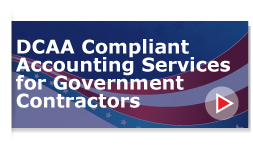Government forms - they're a given when you work as a government contractor, but that doesn't make them any easier to understand. Use this handy guide to learn when a Cost Accounting Standards Disclosure Form is required and how to complete it.
The CASB DS-1
The Cost Accounting Standards Board Disclosure Statement (CASB DS-1) is the form required by Public Law 100-679 for contractors and subcontractors. Its purpose is to provide consistency in reporting of costs. All new contractors are required to submit a CASB DS-1 before a contract of $50 million or more is awarded. For contracts less than $50 million, new contractors must submit a CASB DS-1 within six months of the awarded contract. The 42-page document consists of eight sections, each with applicable instructions.
I. General Information
This section identifies your company and is relatively self-explanatory. It includes pertinent information such as:
- Company name and contact information
- Official contact person for the statement
- Statement type
- Federal agent and auditor to whom the statement will be submitted
- Identification of unallowable, incurred and estimated costs
- Fiscal year and cost accounting period
II. Direct Costs
This section is intended as a statement of direct material, direct labor and other direct costs. Be prepared to disclose for each direct material cost.
- Method of charging
- Time frame for charging
- Types of variances
- Production levels
- Disposition methods
- Revisions
Direct labor cost disclosure explains your method of charging for labor, variances and dispositions. Any other direct costs, such as employee travel expenses or credits are also included in this section.
III. Direct versus Indirect Costs
This section is used to identify the treatment of costs. For each item on the list, you’ll assign a treatment code and list the name of the pool. The treatment codes to be used are:
A. Direct material
B. Direct labor
C. Direct material and labor
D. Other direct costs
E. Sometimes direct/Sometimes indirect
F. Indirect only
Y. Other(s) (Must be described on a continuation sheet.)
Z. Not applicable
IV. Indirect Costs
This section divides indirect costs into three categories:
- Manufacturing, engineering and comparable indirect costs
- General and administrative
- Service center and expense pool costs
There are 18 Allocation Base Codes provided for identification of each indirect cost. Use these along with the description of the major functions for each indirect cost you list. For service centers and expense pools, you’re allowed to assign up to three codes.
You’ll then mark the appropriate box for how variances are treated, assign one of five rate codes to overhead applications and identify independent research and development (IR&D) and bid and proposal (B&P) allocations as well as cost of facilities capital.
V. Depreciation and Capitalization Practices
For each tangible asset listed, assign the appropriate code for each of the four columns. The columns indicate:
- Depreciation method
- Useful life
- Property units
- Residual value
Then, mark whether the listed items are expensed or capitalized, how gains and losses on dispositions are treated, the criteria for capitalization and if there are group or mass purchases.
VI. Other Costs and Credits
In this section, you’ll identify methods of charging for:
- Vacation, holiday and sick pay
- Other benefits, severance and early retirement pay
- Incidental receipts
- Employee welfare activities
VII. Deferred Compensation and Insurance Cost
For this section, you may need to consult with your human resources department as well as your accounting records. Although lengthy, this section is broken up into the different types of deferred compensation and insurance such as pension plans, employee stock ownership plans, workers’ comp and post-retirement benefits plans. For each type of coverage, you’ll assign a code for each of five columns:
- Cost accumulation
- Cost basis
- Crediting of dividends and earned refunds
- Projected average loss
- Insurance administrative expenses
Be sure to assign a code from each respective column code list. If your company does not directly incur these costs, identify the business unit that does incur these and complete a continuation sheet for each.
VIII. Home Office Expenses
To complete this section, provide your organizational structure, if there have been any previous CAS-covered government sales and if so, what percentage those sales cover of your total sales.
Tips for Completion
- If you need help with applicable definitions, refer to 48 CFR 9904.401-30.
- Be sure to list the Reporting Unit Name at the top of each page.
- Any time you see “1/” you’ll need to complete a continuation sheet for that item.
- For narrative answers, you may need more space than that provided on the primary page. In these instances, make as many copies of the provided continuation sheet as needed. Attach them at the end of the relevant section and be sure to include “End of Part” after the final entry on the sheet.
- If referencing a written accounting policy that you have already submitted in your Preaward Survey, a copy of the relevant portion of the document may be submitted as appendices to the relevant part.
- If your policies change, provide an amendment with references to the original Disclosure Statement and file with the same agency as the original.
Filing Your Form
After completing the CASB DS-1, file the original and one copy with the relevant ACO or federal agency official acting in that capacity and one copy with your auditor. Always keep a copy for your own company records. Any amendments and revisions must be submitted in the same manner.
Although it may take a while, completing the CASB DS-1 correctly the first time will save you time and money in the future. Take your time and celebrate your success after the form is on its way.















